The device and installation of electric floor heating - cable, on the base and infrared
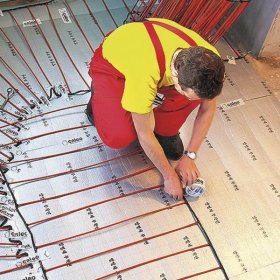
The warm floor, which until relatively recently was something unattainable, being an exclusive element in the arrangement of housing, has now become a fairly ordinary thing, affordable, friendly to operate, easy to install. Advanced technologies for the production of electric underfloor heating make it possible to obtain not only an efficient energy-saving room heating system, but also to equip it without any problems.
Content
Comparative characteristics of electric underfloor heating
It is recommended to select the electric underfloor heating for heating housing in such a way, based on the characteristics of a particular apartment or individual house, so that the selected system generates the necessary amount of heat, is economical in terms of energy consumption and does not present any particular difficulties during installation.
Ease of installation is especially important if you decide to equip an electric heated floor with your own hands.
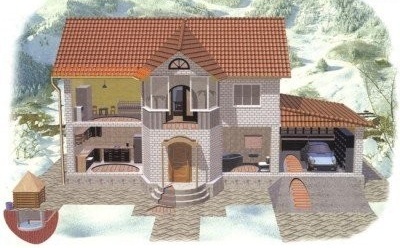
The heating system "warm floor" can be used in any room and under any floor covering, in addition, it can be used for outdoor work
The types of underfloor heating currently on the market of building materials have a different configuration and a wide range of power indicators, which simplifies the moment of choice and allows you to purchase a heating system that best suits the needs of your home. Varieties of electric underfloor heating:
- cable
- cable based
- film infrared
We offer to consider each species in more detail.
The easiest cable option
The main functional element of the cable underfloor heating device is a heating element in the form of a wire, which transforms electricity into heat.
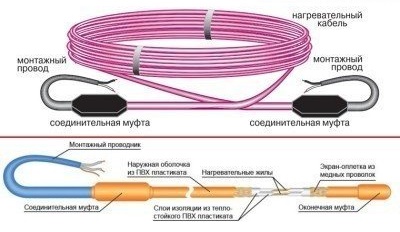
The underfloor heating cable consists of two conductive cores, fiberglass reinforcement, a polyester film, a copper conductor, an aluminum shield and a PVC protective layer
Of all types of electric floors, the cable heating system is the most difficult and time-consuming to install, as it requires careful laying of the cable with a given step and the obligatory finishing stage - filling the screed. An additional screed layer with a thickness of about 5 cm leads to a noticeable loss in the height of the room, which acts as a fundamental point when laying this type of heating in apartments of high-rise buildings.Another significant drawback of cable underfloor heating is the impossibility of laying it under furniture and plumbing fixtures. However, this type of electric floor has undeniable advantages - a heating cable can be used for installation in rooms with a complex perimeter, as well as for heating the external elements of a private house - roof, tides, drains.
Cable floor on the base
The cable underfloor heating on the base has a small thickness and is a mesh mat on which a heating cable with a cross section of about 2.8 mm is fixed. Compared to cable, this type of underfloor heating is easier to install, since the heating wire is laid and fixed on the base, so the installation process consists in the layout and fixing of the mats.
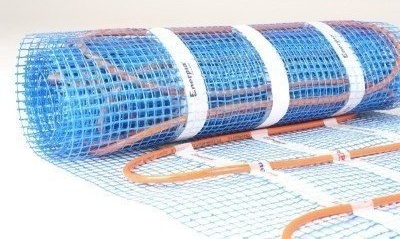
A convenient option for installation is a warm floor in the form of heating mats, consisting of a mesh base and a fixed cable
The cable floor on the grid is the most suitable option for installation under the tile, since the thickness of the layer of adhesive is quite enough for the floor mats to be in its thickness. If this type of electric floor is installed under the laminate, carpet or linoleum, then filling the screed will be required, but its thickness will be small - about 3 cm. It should be noted that it is not recommended to lay the cable underfloor heating on the base in those areas of the room where furniture or sanitary equipment is supposed to be placed.
Often during repair there are unusual situations. For example, laying a new tile on top of an old tile, but that is not all, in this case a floor heating system is provided. Read more about the installation features here:https://aquatech.tomathouse.com/en/voprosy/ustanovka-tyoplogo-pola-na-kafel-mozhno-li.html.
Infrared film
The infrared warm floor is produced in the form of a two-layer film with carbon heating elements and has a thickness of about 0.5 mm, which allows you to keep the height of the room unchanged, unlike other warm floors.
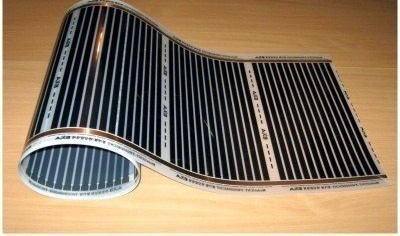
The infrared floor consists of two layers of electrical polyester, between which carbon heating elements and conductive copper foil are placed
Moreover, the infrared floor is the most energy-efficient among other heating systems - during its operation, about 60% of electricity is saved. Laying an electric underfloor heating with infrared heating elements is the simplest of all possible - film strips are spread on the base of the floor without taking into account the arrangement of furniture, and the floor covering is installed immediately, without the laborious process of filling the screed.
It is important to know: Film infrared warm floors can be installed on any surface - horizontal, vertical, inclined due to the so-called “dry installation”.
How to make an electric underfloor heating on your own with the least financial investment and labor costs, while receiving a high-quality heating system? The answer is simple - you need to choose the best option for a warm floor, which according to the technical characteristics will meet the needs of your home, and its installation will not be difficult if installed on its own.
Step-by-step installation instructions
Floor preparation
Since the installation of electric underfloor heating belongs to the category of “finishing” construction work, this process is carried out after the walls and ceilings are plastered, the screeds are flooded - that is, the “rough” stages of construction are completed. Characteristically, at the end of these stages, the base of the floor is usually covered with a layer of dust and dirt, there are fragments of hardened plaster and cement mortar on it.To clean the surface of the base for installing a warm electric floor, it is necessary to remove the hardened pieces of the solution with a spatula or use a special solvent, then moisten the floor with water and sweep away the remains of building mixtures, debris, dust with a brush.
It is important to know: In order for the warm floor to function properly, without overheating and short circuits, the base surface - the concrete base, must be flat, without significant level differences.
Laying floor insulation
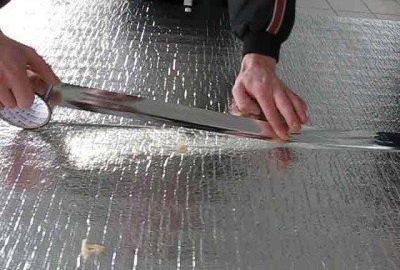
Laying thermal insulation on a warm floor is necessary to reduce heat loss and create directed heat flows
Pay attention to such a feature of the underfloor heating system that its functioning is accompanied by the spread of heat in all directions, therefore, not only the floor surface of the heated room will be heated, but also the concrete base with which the heating elements come into contact.
In order to minimize heat loss and prevent the heating of floor slabs, a heat-insulating material is mounted under the warm floor. Thermal insulation shields heat fluxes, reflects them and directs them into the heated zone. Based on whether the room is heated or not heated, it is below the level relative to the room in which the heated floor is installed, the type and thickness of the insulation is selected.
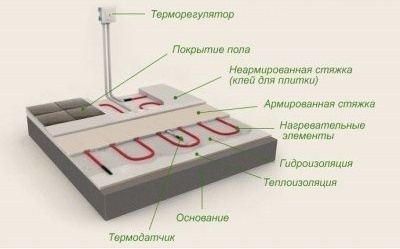
An important stage in arranging a floor heating system is the installation of thermal insulation, on which the heating elements of the warm floor are laid
When arranging an electric heat-insulated floor in an apartment of a multi-storey building, where heated rooms are located below the floor, a foil-rolled roll insulation material of small thickness of the order of 3-4 mm is used. The insulation strips are laid out, carefully docked and fixed with a stapler to the base base to prevent material from shifting relative to the floor surface. In addition, you can glue the joints of the insulation strips with mounting tape.
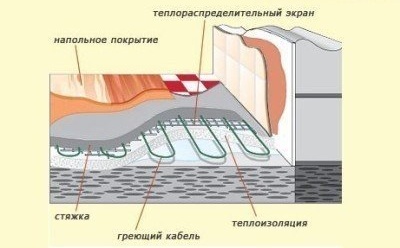
Arrangement of a warm floor in rooms adjacent to unheated areas requires the installation of thermal insulation with a thickness of about 10 cm
In the case when the underfloor heating is laid in a private house, where the heated room may be located above the unheated one, foam insulation or another 5-10 cm thick insulating plate material in combination with a heat-reflecting foil layer is used as thermal insulation.
Connection of thermostat and temperature sensor
Before you begin installing the heating elements of the warm floor, you must install the thermostat and connect a temperature sensor to it. The temperature regulator, with which the temperature regime of the warm floor is varied, is mounted on the wall in a convenient place, at a height of at least 30 cm from the floor surface. A device that measures the current heating temperature, a temperature sensor, is laid in the thickness of a warm floor at a distance of 50-70 cm from the wall on which the thermostat is located.
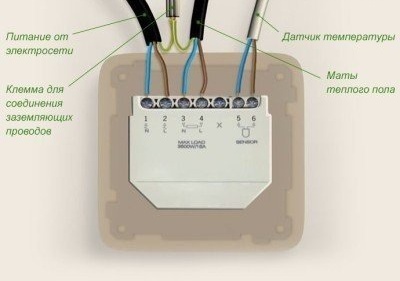
The heating of the underfloor heating is controlled by a thermostat, to which the heating elements and the temperature sensor are connected
The electric floor heating connection scheme involves connecting a cable coming from the heating elements of the warm floor, a corrugated tube with a temperature sensor inside and wires from the central power supply to the thermostat. When the underfloor heating is switched on in the heating mode, the indicator should light up on the front panel of the thermostat, while the underfloor heating elements will begin to generate heat.
Laying underfloor heating elements
The technology for laying an electric underfloor heating provides for the layout of heating elements with spacing from the walls of about 5 cm, from heating devices - about 10 cm.Based on which option of the heated floor is selected - cable, cable on the base or infrared, the installation of the electric warm floor is carried out throughout the room or only in that part where the arrangement of furniture, plumbing fixtures or other interior items is not supposed. It must be remembered that cable underfloor heating is not laid under furniture and plumbing. Thinner in thickness - film infrared floor, can be mounted in any zone, regardless of the placement of floor elements of the arrangement of the room.
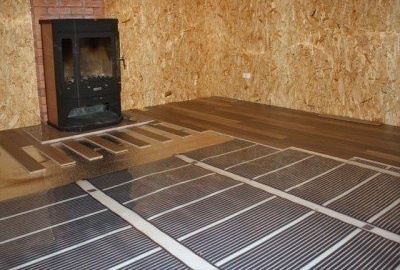
The infrared film underfloor heating is characterized by the simplest installation scheme and can be mounted under any floor covering
During the installation of the infrared or cable underfloor heating on the grid, the fastening of the strips with heating elements to the base of the floor is carried out using double-sided tape, the mats are connected to each other using mounting tape. When laying a cable underfloor heating, segments of the mounting tape are attached to the base surface in increments of 0.5 to 1 meter using dowels or screws, after which the heating cable is laid out at a given step and fixed on the tape.

Electric underfloor heating can even be installed under such a “capricious” floor covering such as parquet
The layout of the heating cable is in the form of a “snake”, where the step between the turns is set at least 8 cm, but in order to determine exactly this distance, you can calculate it this way: 100 times the room area and divide by the length of the floor heating cable.
It is important to know: When installing the heating wire of the cable underfloor heating, it is necessary to ensure that the cable does not stretch, its bends are smooth, without kinks and internal stress.
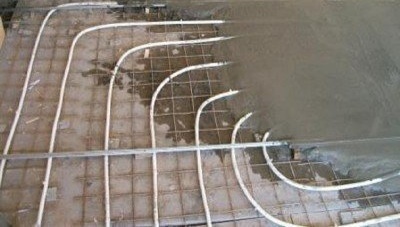
At the final stage of arranging a cable underfloor heating, a layer of cement screed about 5 cm is mandatory to be poured
The final stage of laying the cable underfloor heating is to fill the screed, which must be left to stand for 30 days, after which the floor covering is mounted.
The device of an electric heated floor based on infrared heating elements is convenient in that it does not require the formation of a screed - the finish flooring is installed directly on the warm floor.
One of the varieties of infrared underfloor heating is carbon floors. About their pros and cons, as well as about the features of installation, read in our article:https://aquatech.tomathouse.com/en/otoplenie/teplyj-pol/karbonovyj-teplyj-pol.html.
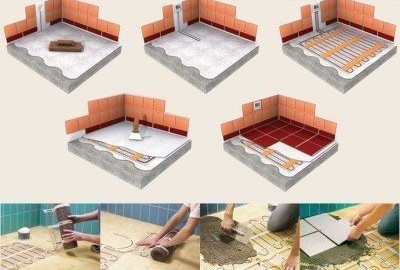
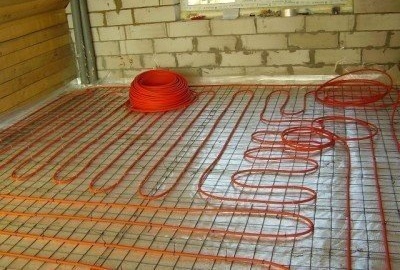

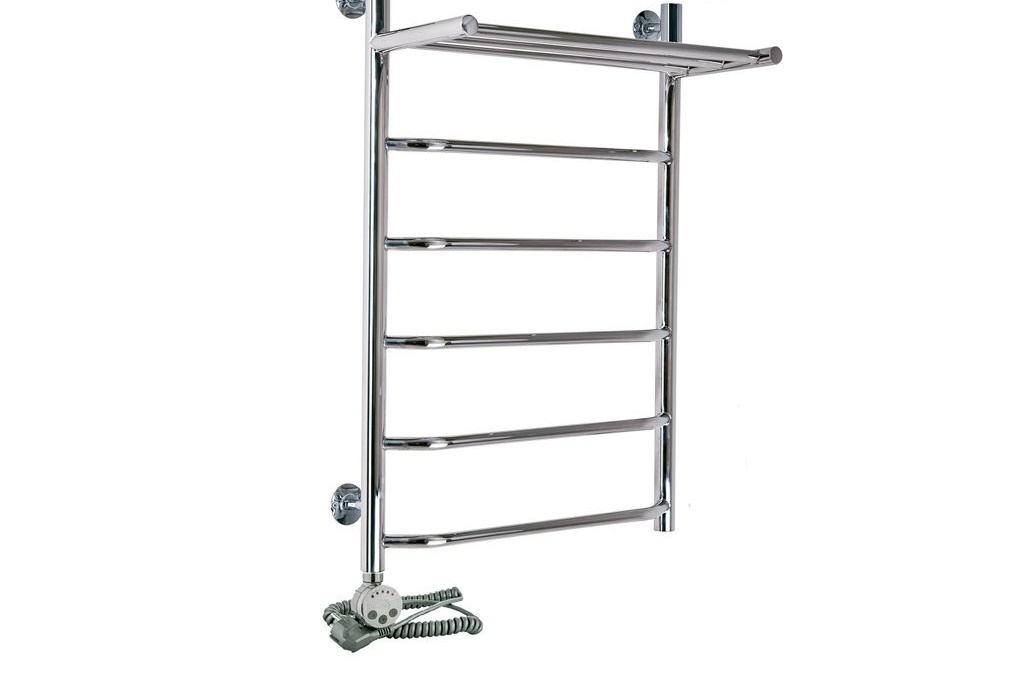
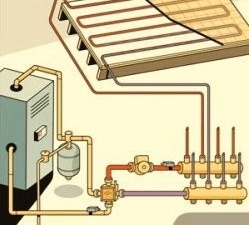
2 comments